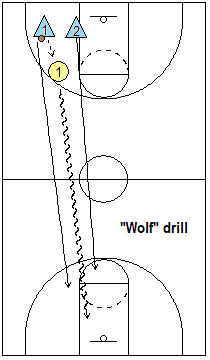Basketball Drills - Trapping Drills
By Dr. James Gels, From the Coach’s Clipboard Basketball Playbook"Helping coaches coach better..."
Disclosure: This page contains affiliate links, which means that Coach's Clipboard receives a small commission (at no cost to you) if you make a purchase using these links.
Circle Trap Drill
This is a defensive drill from Coach Larry Shyatt (former University of Wyoming Head Coach and former Dallas Mavericks assistant coach). It teaches players how to trap anywhere on the court. It also is a good offensive ball-handling and passing drill, under pressure.
Setup: - Diagram 1 - use 6 players (3 yellow, 3 white) alternating around a circle. Each player takes one step back off the circle. You want the players to maintain this diameter circle and spacing throughout the drill. Coach has the ball.
The Drill:
Coach passes to any player - here O1. The adjacent opponents X1 and X3 immediately set a legal trap on O1. Trappers must have their feet wide and adjacent to each other with arms up and out. The player with the ball O1 is not allowed to dribble and tries to pass to either of his/her teammates, while the remaining defender X2 acts as an interceptor, gapping the two offensive players. O1 stays low and never puts the ball above his/her head as this would allow trappers to close in tighter. He/she uses pass-fakes and works on pivoting to make a pass.
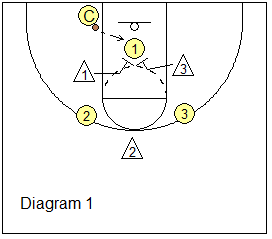
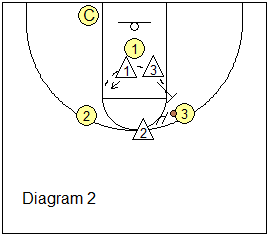
Diagram 2 - when the ball is passed (here to O3), X2 closes to trap and X3 immediately sprints out of the trap to now trap the ball (O3) again. X1 becomes the interceptor. And so the drill progresses. After a stop in play, next time the coach will pass to a player on the other team so that everyone gets both trapping and offensive work.
With a 12-player team, you can run 6 on each end at the same time. You can also set the circles on different places on the court to mimic where you usually like to trap - e.g. near the endline if you like to trap off a full-court press, or near half-court for half-court or 1-3-1 trapping defenses.
Deny and Trap Corner Drill
This is a defensive drill that emphasizes defensive slides, forcing the opponent to the baseline, and then trapping at the baseline.
Setup: (blue = assistants, red = defense)
Use both sides of the half court, with an assistant holding a ball on each wing, free-throw line extended. He/she should hold the ball extended out with one hand toward the defender (X1).
The Drill:
Diagram A. The defenders at the free-throw line (X1 and X2) slide over and back twice and touch the ball each time, being vocal ("deny, deny, deny"). On the third slide, before the defender can touch the ball, the assistant starts dribbling. The defender forces him to the baseline, where the low block defenders (X3 or X4) seal off the baseline and prevent further penetration along the line, and the two defenders trap in the corner, or along the baseline (Diagram B).
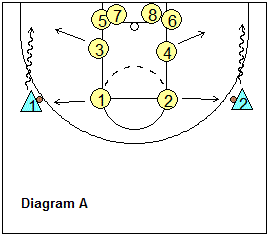
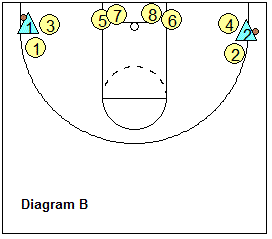
Once the assistant is trapped, the low block defender rotates up to the free-throw line, the next player in line becomes the new low block defender, and X1 goes to the rear of the line.
Pointers:
1. Make sure the defense prevents penetration along the baseline.
2. Don't allow the ball-handler to split the trap. Trappers get "knee to knee".
3. When trapping, don't reach in. The height of the trappers' hands should mirror the height of the ball. We are going for a deflection, a bad pass, a 5-second call and lastly the tie-up and jump ball. If the offensive player presents the ball to you, go ahead and get the tie-up, jump-ball - but otherwise, don't reach-in for the ball.
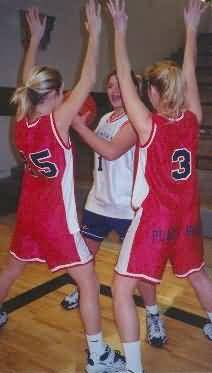
"Wolf" Back-Tip Drill
This drill comes from Jamion Christian, George Washington University Head Men's Basketball Coach.
While not actually a trapping drill, learning to back-tip correctly is an important player fundamental that all good pressing teams should drill. A back-tip occurs when the offensive player with the ball speed dribbles past a defender, and then the defender turns and sprints after the ball, trying to tip it from behind.
Too often, the defensive player tries to slap at it from above with a downward motion, resulting in a foul. Instead, the defensive player should get his hand low near the floor while sprinting and tip the ball from below with an upward motion. This usually results in a clean tip, with no foul. See the video.
The Drill:
See the diagram and video. Two players are on defense, one on offense. One defender passes the ball to the offensive player, and he takes off speed-dribbling to the far hoop for a lay-up. The two defenders sprint after him trying to back-tip the ball from behind and below. The offensive player becomes a defender on the trip back on the opposite side of the court.
